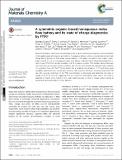| dc.contributor.author | Duan, Wentao | |
| dc.contributor.author | Vemuri, Rama S. | |
| dc.contributor.author | Milshtein, Jarrod D. | |
| dc.contributor.author | Laramie, Sydney | |
| dc.contributor.author | Dmello, Rylan D. | |
| dc.contributor.author | Huang, Jinhua | |
| dc.contributor.author | Zhang, Lu | |
| dc.contributor.author | Hu, Dehong | |
| dc.contributor.author | Vijayakumar, M. | |
| dc.contributor.author | Wang, Wei | |
| dc.contributor.author | Liu, Jun | |
| dc.contributor.author | Darling, Robert M. | |
| dc.contributor.author | Thompson, Levi | |
| dc.contributor.author | Smith, Kyle | |
| dc.contributor.author | Moore, Jeffery S. | |
| dc.contributor.author | Wei, Xiaoliang | |
| dc.contributor.author | Brushett, Fikile R | |
| dc.date.accessioned | 2017-04-07T16:38:08Z | |
| dc.date.available | 2017-04-07T16:38:08Z | |
| dc.date.issued | 2016-03 | |
| dc.date.submitted | 2016-02 | |
| dc.identifier.issn | 2050-7488 | |
| dc.identifier.issn | 2050-7496 | |
| dc.identifier.uri | http://hdl.handle.net/1721.1/107941 | |
| dc.description.abstract | Redox flow batteries have shown outstanding promise for grid-scale energy storage to promote utilization of renewable energy and improve grid stability. Nonaqueous battery systems can potentially achieve high energy density because of their broad voltage window. In this paper, we report a new organic redox-active material for use in a nonaqueous redox flow battery, 2-phenyl-4,4,5,5-tetramethylimidazoline-1-oxyl-3-oxide (PTIO) that has high solubility (>2.6 M) in organic solvents. PTIO exhibits electrochemically reversible disproportionation reactions and thus can serve as both anolyte and catholyte redox materials in a symmetric flow cell. The PTIO flow battery has a moderate cell voltage of ∼1.7 V and shows good cyclability under both cyclic voltammetry and flow cell conditions. Moreover, we demonstrate that FTIR can offer accurate estimation of the PTIO concentration in electrolytes and determine the state of charge of the PTIO flow cell, suggesting FTIR as a powerful online battery status sensor. This study is expected to inspire more insights in this under-addressed area of state of charge analysis aiming at operational safety and reliability of flow batteries. | en_US |
| dc.language.iso | en_US | |
| dc.publisher | Royal Society of Chemistry | en_US |
| dc.relation.isversionof | http://dx.doi.org/10.1039/c6ta01177b | en_US |
| dc.rights | Creative Commons Attribution 3.0 Unported licence | en_US |
| dc.rights.uri | http://creativecommons.org/licenses/by/3.0/ | en_US |
| dc.source | Royal Society of Chemistry | en_US |
| dc.title | A symmetric organic-based nonaqueous redox flow battery and its state of charge diagnostics by FTIR | en_US |
| dc.type | Article | en_US |
| dc.identifier.citation | Duan, Wentao et al. “A Symmetric Organic-Based Nonaqueous Redox Flow Battery and Its State of Charge Diagnostics by FTIR.” J. Mater. Chem. A 4.15 (2016): 5448–5456. © 2016 The Royal Society of Chemistry | en_US |
| dc.contributor.department | Massachusetts Institute of Technology. Department of Chemical Engineering | en_US |
| dc.contributor.mitauthor | Brushett, Fikile R | |
| dc.relation.journal | Journal of Materials Chemistry A, materials for energy and sustainability | en_US |
| dc.eprint.version | Final published version | en_US |
| dc.type.uri | http://purl.org/eprint/type/JournalArticle | en_US |
| eprint.status | http://purl.org/eprint/status/PeerReviewed | en_US |
| dspace.orderedauthors | Duan, Wentao; Vemuri, Rama S.; Milshtein, Jarrod D.; Laramie, Sydney; Dmello, Rylan D.; Huang, Jinhua; Zhang, Lu; Hu, Dehong; Vijayakumar, M.; Wang, Wei; Liu, Jun; Darling, Robert M.; Thompson, Levi; Smith, Kyle; Moore, Jeffery S.; Brushett, Fikile R.; Wei, Xiaoliang | en_US |
| dspace.embargo.terms | N | en_US |
| dc.identifier.orcid | https://orcid.org/0000-0002-7361-6637 | |
| mit.license | PUBLISHER_CC | en_US |
